Key takeaways:
- Animal communication involves conveying feelings and intentions through vocalizations, gestures, and body language, revealing rich emotional connections between species.
- Protecting animal welfare is crucial for both animal and ecosystem health, emphasizing our shared responsibility towards the voiceless and the importance of empathy in human-animal relationships.
- The Animal Protection Society educates communities on animal rights and welfare, advocating for responsible pet ownership and the interconnectedness of all life.
- Experiences from animal communication classes highlight how understanding animals can facilitate healing and enhance their quality of life, transforming human-animal bonds.
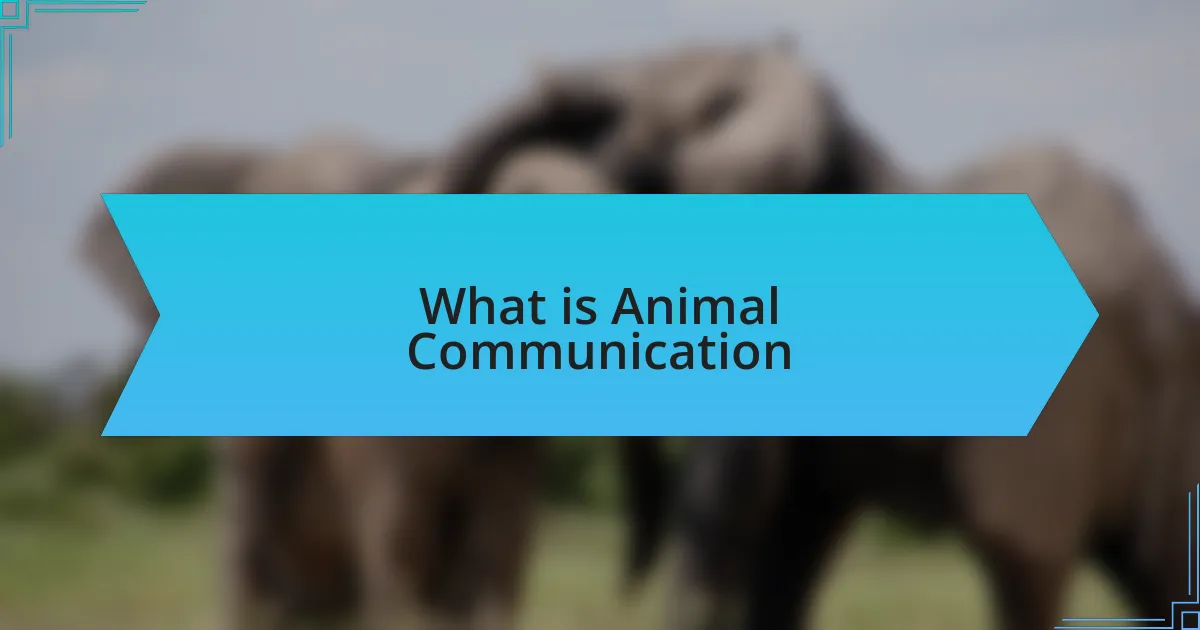
What is Animal Communication
Animal communication is the way animals convey feelings, thoughts, and intentions to one another and, at times, to us. I remember the first time I observed my dog, Bella, communicate her needs through different barks and body language. It struck me how each sound and posture held meaning, much like human language does.
In essence, animal communication encompasses vocalizations, gestures, and even subtle changes in behavior. Have you ever noticed how your cat can express affection with a gentle purr or a slow blink? These subtle cues reveal a rich emotional landscape that many of us often overlook.
The depth of animal communication also extends beyond sounds and movements. For example, I once participated in a workshop where we learned about the intuitive ways that animals react to human emotions. It was fascinating to realize that animals can sense our feelings, creating a unique bond that transcends mere words. This makes me wonder how often we underestimate our connection with them.

Importance of Animal Protection
Animal protection is essential not only for the welfare of animals but also for our environment and society as a whole. I recall volunteering at a local shelter and witnessing first-hand the joy that a rescued animal can bring into someone’s life. It’s remarkable how protecting these beings enriches the human experience, reminding us of our shared responsibility toward the voiceless.
Furthermore, the overexploitation and mistreatment of animals have dire consequences for biodiversity and ecosystem health. For example, I once attended a seminar on wildlife conservation where the speaker highlighted the collapse of certain ecosystems due to the extinction of key species. It’s a striking reminder that every animal plays a crucial role in maintaining the balance of nature. Can we really afford to lose that?
The bond between humans and animals is profound and mutual. I often think about my interactions with pets or wildlife; they seem to reflect our emotions and, in turn, teach us empathy. Protecting animals not only safeguards their well-being but also cultivates compassion within ourselves, leading to a more harmonious existence. Isn’t that something we should strive for?
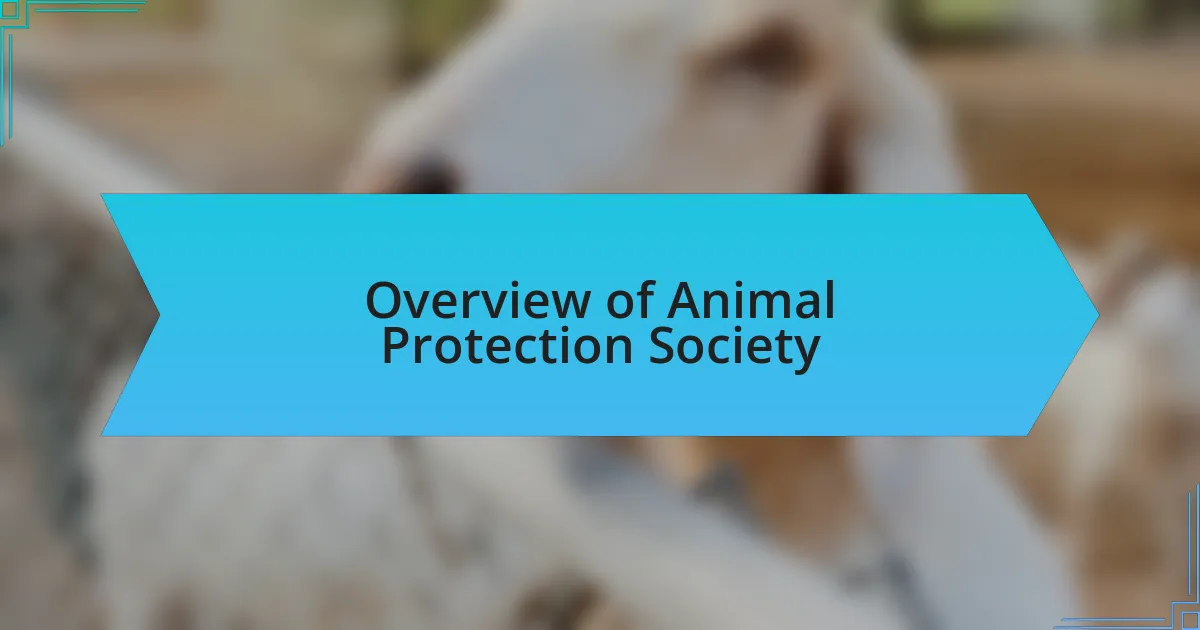
Overview of Animal Protection Society
The Animal Protection Society is an organization that embodies the commitment to safeguarding the welfare of all creatures. I remember my first experience attending one of their outreach events; the dedication of volunteers was inspiring as they shared stories of rescued animals and the challenges faced in advocating for their rights. It struck me how powerful a collective voice can be in not just protecting animals but also in educating the public about responsible pet ownership and wildlife conservation.
At the core of their mission lies a deep understanding of the interconnectedness of all life. I’ve had moments of reflection while observing the varied species that share our planet, and I can’t help but wonder: what would happen if we all took a little more initiative to protect the fragility of these ecosystems? The society works tirelessly, emphasizing that the health of animals directly impacts environmental sustainability.
By actively engaging communities in animal welfare issues, the Animal Protection Society creates ripples of change. I fondly recall volunteering at a workshop where we taught children the importance of kindness to animals; their wide eyes and thoughtful questions reminded me of our responsibility to be stewards of the Earth. Isn’t it magical to think that small actions can lead to significant transformations in how we coexist with animals?
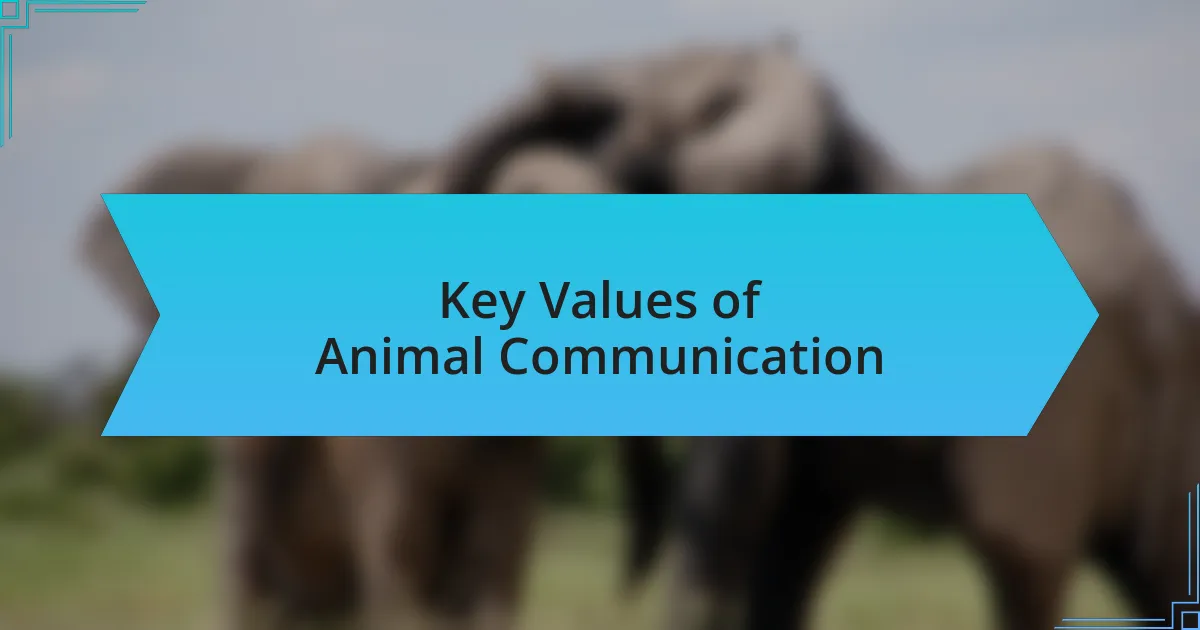
Key Values of Animal Communication
The essence of animal communication lies in empathy. I remember attending a workshop where participants paired up with different animals and practiced understanding their signals. It was a profound experience to hear about how a dog’s wagging tail doesn’t just signify happiness; it can also express anxiety or excitement. Isn’t it fascinating how much we can learn about an animal’s emotions simply by tuning into their body language?
Another key value is the ability to foster trust between humans and animals. In my own journey, I’ve seen how spending time observing and listening to animals has transformed my relationships with them. For instance, when I took the time to sit quietly with a horse, I could almost feel its heartbeat slow as it recognized my calm presence. This connection emphasizes that, often, we’re merely a heartbeat away from deepening our bond with these sentient beings.
Lastly, animal communication instills a greater sense of responsibility toward their welfare. Each time I lead a class, I notice attendees leaving with a spark of understanding—realizing that their actions directly influence the well-being of these creatures. When we commit to communicating effectively, are we not also committing to listening and advocating for their rights? This transformative journey equips us to be kinder, more aware stewards of the animals in our lives.
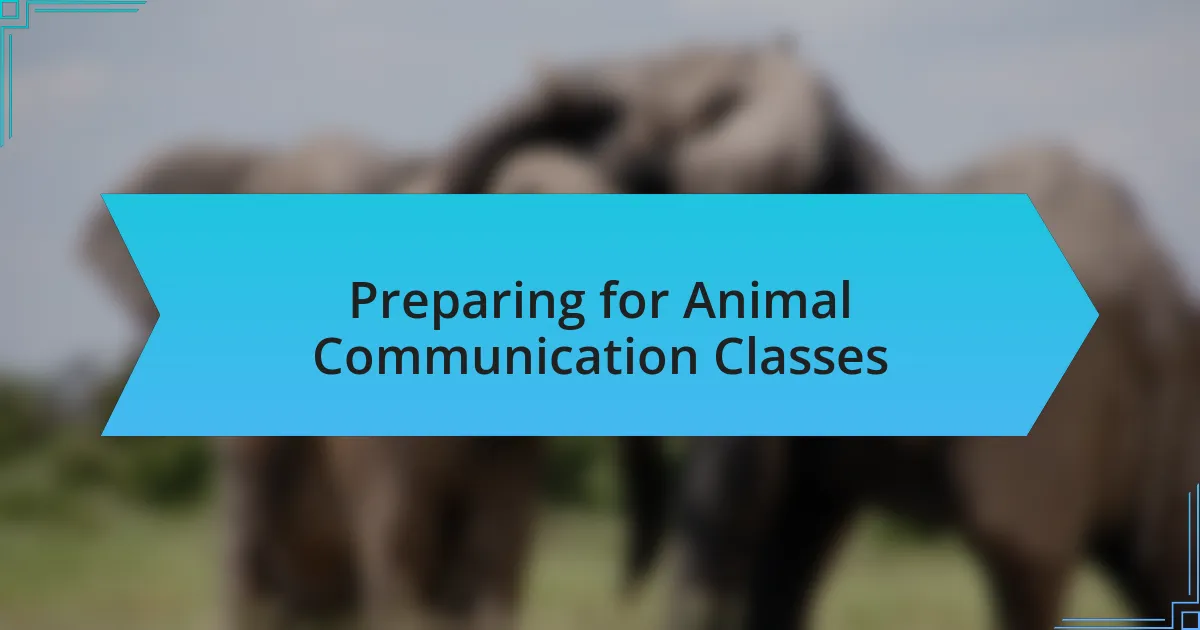
Preparing for Animal Communication Classes
Preparing for animal communication classes requires not just knowledge, but an open heart. I recall the night before my first class, I found myself lying awake, feeling a mix of excitement and nervousness. How could I convey the depth of connection I had felt with animals? Embracing that vulnerability became the foundation for building rapport with my students.
It’s essential to create a calming environment that fosters trust. I personally like to set up a cozy space with soft lighting and soothing music, enveloping the atmosphere in warmth. Once, after I incorporated gentle background sounds, a participant shared how it made her feel at ease to open up about her relationship with her cat. Isn’t it interesting how the right ambiance can unlock a deeper level of connection?
Lastly, I believe that self-reflection is crucial. Before each class, I take time to ground myself, often engaging in meditation or journaling about my own experiences with animals. During one reflective session, I remembered the transformative bond I had with a rescue dog, which truly anchored my passion for this work. How can we teach others about communication if we don’t first understand our own stories with animals? This personal journey fuels my commitment to help others bridge that same gap.
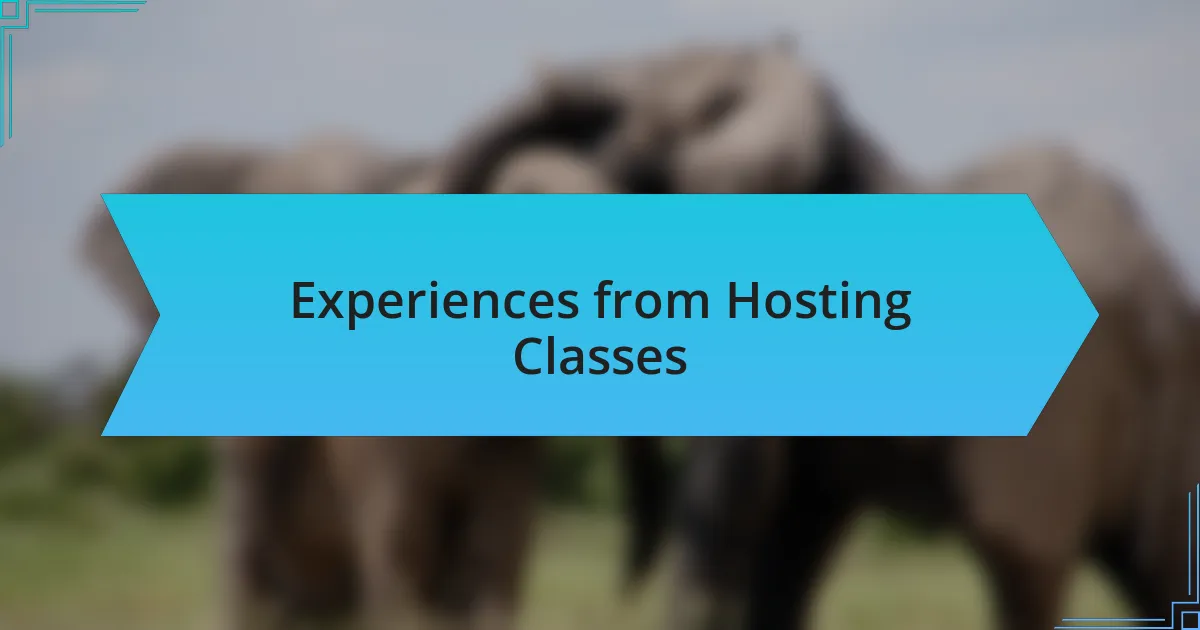
Experiences from Hosting Classes
When I hosted my first animal communication class, I was struck by how hesitant some participants were to share their experiences. One woman sat quietly, her expression a mix of curiosity and fear. After a gentle nudge, she finally opened up about her childhood dog and the profound bond they shared. It was a reminder that vulnerability often invites connection, and that moment felt incredibly powerful for both of us.
During another session, I witnessed a breakthrough moment that I still cherish. A participant, after some practice, connected with her aging cat and described vividly a shared memory of playfulness. The tears that followed were a mix of joy and nostalgia. It made me realize how communication transcends words; it’s about feelings, memories, and the joy of understanding one another. Isn’t it amazing how animals can teach us so much about ourselves?
I’ve noticed that the classes often become a space for healing. I remember a young man who had lost his beloved dog just weeks before attending. He entered the class guarded but left with a sense of peace after connecting with his pet spirit. Watching someone transform their grief into a celebration of love is profoundly moving. Ultimately, these experiences reinforce my belief that animal communication is not merely a skill; it’s a journey toward understanding the depths of our connections with these incredible beings.
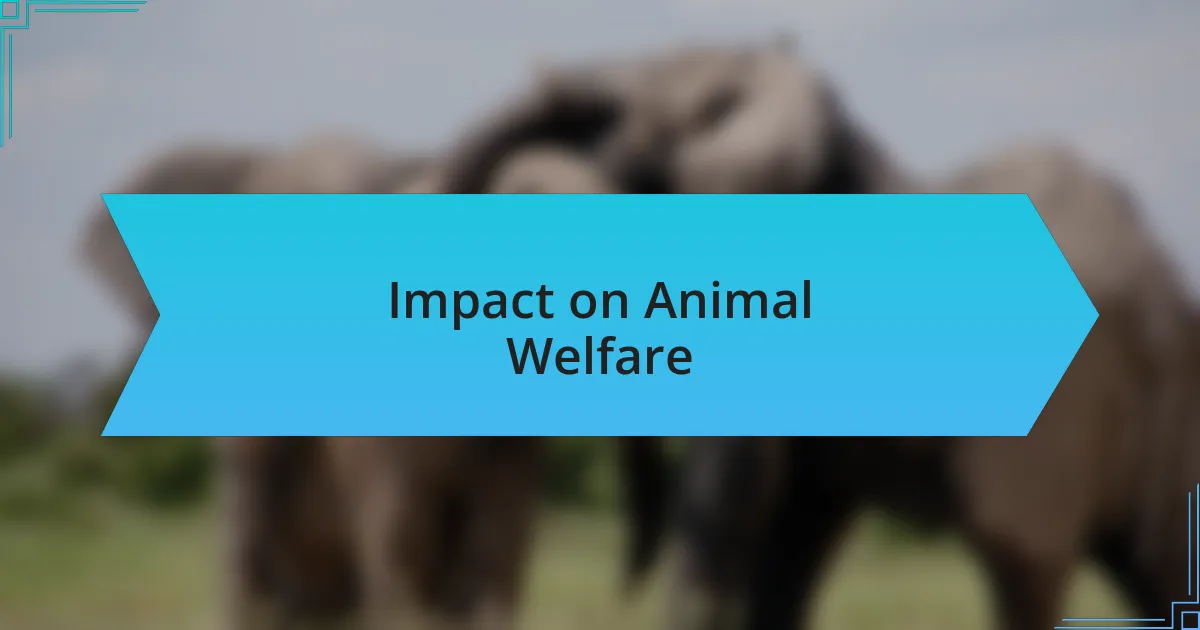
Impact on Animal Welfare
The impact on animal welfare became increasingly evident as participants learned to communicate with their animals. I recall a woman who adopted a rescue dog, initially struggling with trust issues. Through our sessions, she discovered that the dog craved reassurance and a sense of safety, ultimately forging a bond that transformed his behavior and, in turn, enhanced his liveliness and happiness.
During another class, I encountered a participant who owned a horse that had been neglected. As she practiced her communication techniques, she began to understand the horse’s fears and frustrations. This newfound awareness led her to change her approach, addressing underlying issues with gentleness and patience. Witnessing this transformation reaffirmed my belief that deeper understanding can directly improve an animal’s quality of life.
As these connections deepen, I often find myself pondering: how many animals are waiting for us to truly listen? By nurturing this dialogue, we fuel a compassionate approach to animal care, reducing stress and fostering a supportive environment for animals in need. The ripple effects of this understanding extend beyond the individual animal to the collective mindset surrounding animal welfare.